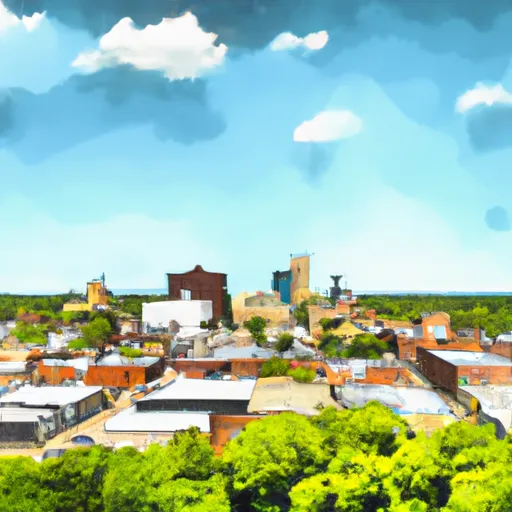-
 Snoflo Premium
Snoflo Premium
Get unlimited access to all our content
With no Ad interruptions! - Start Your Free Trial Login with existing account
Russellville
Eden Index
Climate
8.0
•
Recreation
3.7
•
Community
•
Safeguard
4.5/10

Russellville, Indiana is a small town located in Putnam County, in the central part of the state. The climate in Russellville is classified as humid continental, characterized by hot summers and cold winters. Average temperatures range from around 20°F (-7°C) in winter to 85°F (29°C) in summer. Precipitation is evenly distributed throughout the year, with an average annual rainfall of about 40 inches (102 cm).
In terms of hydrology constituents, Russellville is situated near the Big Walnut Creek, which provides a scenic backdrop and recreational opportunities. The creek is known for its diverse fish population, including bass, catfish, and sunfish, attracting anglers.
Outdoor enthusiasts in Russellville can take advantage of various recreational activities. The area offers opportunities for hiking, camping, and picnicking in nearby parks such as Lieber State Recreation Area and Deer Creek Fish and Wildlife Area. Russellville is also surrounded by picturesque farmland, providing a pleasant backdrop for walks and bike rides in the countryside.
Overall, Russellville, Indiana offers a moderate climate, access to water bodies like Big Walnut Creek, and a range of outdoor activities to enjoy throughout the year.
What is the Eden Index?
The Snoflo Eden Index serves as a comprehensive rating system for regions, evaluating their desirability through a holistic assessment of climate health, outdoor recreation opportunities, and natural disaster risk, acknowledging the profound impact of these factors on livability and well-being.
Climate Health Indicator (CHI): 8.0
Russellville receives approximately
1071mm of rain per year,
with humidity levels near 82%
and air temperatures averaging around
11°C.
Russellville has a plant hardyness factor of
5, meaning
plants and agriculture in this region thrive during a short period during spring and early summer. Most
plants will die off during the colder winter months.
By considering the ideal temperature range, reliable water supplies, clean air, and stable seasonal rain or snowpacks, the Climate Health Indicator (CHI) underscores the significance of a healthy climate as the foundation for quality living.
A healthy climate is paramount for ensuring a high quality of life and livability in a region, fostering both physical well-being and environmental harmony. This can be characterized by ideal temperatures, reliable access to water supplies, clean air, and consistent seasonal rain or snowpacks.
Weather Forecast
Streamflow Conditions
Wabash
Area Rivers
Wabash
Snowpack Depths
Wabash
Reservoir Storage Capacity
Wabash
Groundwater Levels
Recreational Opportunity Index (ROI): 3.7
The Recreational Opportunity Index (ROI) recognizes the value of outdoor recreational options, such as parks, hiking trails, camping sites, and fishing spots, while acknowledging that climate plays a pivotal role in ensuring the comfort and consistency of these experiences.
Access to outdoor recreational opportunities, encompassing activities such as parks, hiking, camping, and fishing, is crucial for overall well-being, and the climate plays a pivotal role in enabling and enhancing these experiences, ensuring that individuals can engage in nature-based activities comfortably and consistently.
Camping Areas
| Campground | Campsites | Reservations | Toilets | Showers | Elevation |
|---|---|---|---|---|---|
| Dubois County Park | 32 | 575 ft | |||
| Pike State Forest | 25 | 520 ft | |||
| Harpeth River Bridge | None | 393 ft | |||
| Sunset City Park | None | 548 ft | |||
| Montgomery Rec Park | None | 515 ft | |||
| Ferdinand State Forest | 70 | 489 ft | |||
| Glendale State Fish and Wildlife Area | 120 | 495 ft | |||
| West Boggs Park | 220 | 528 ft | |||
| Lincoln State Park | 270 | 467 ft | |||
| Crane MWR Military | None | 594 ft |
Nearby Fishing
Nearby Ski Areas
Catastrophe Safeguard Index (CSI):
The Catastrophe Safeguard Index (CSI) recognizes that natural disaster risk, encompassing floods, fires, hurricanes, and tornadoes, can drastically affect safety and the overall appeal of an area.
The level of natural disaster risk in a region significantly affects safety and the overall livability, with climate change amplifying these risks by potentially increasing the frequency and intensity of events like floods, fires, hurricanes, and tornadoes, thereby posing substantial challenges to community resilience and well-being.
Community Resilience Indicator (CRI):
The Community Resilience Indicator (CRI) recognizes that education, healthcare, and socioeconomics are crucial to the well-being of a region. The CRI acknowledges the profound impact of these elements on residents' overall quality of life. By evaluating educational resources, healthcare accessibility, and economic inclusivity, the index captures the essential aspects that contribute to a thriving community, fostering resident satisfaction, equity, and social cohesion.

